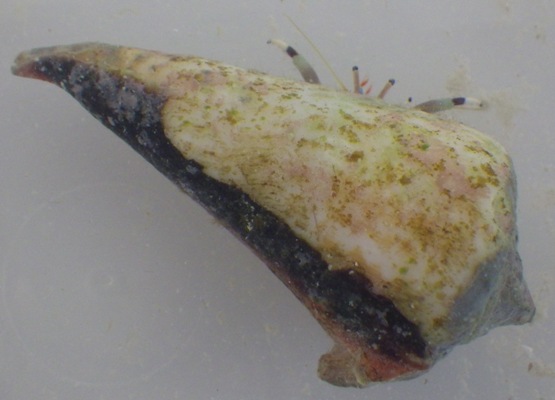Summary
Physical Description
Ecology
Symbionts & Parasites
Shell Selection
Adaptation
Life History & Behaviour
Anatomy & Physiology
Segmentation & Appendages
Evolution & Systematics
Biogeographic Distribution
Conservation & Threats
References & Links | Symbionts & Parasites
The shells of hermit crabs support a range of symbionts. Although the encrusted shell can be beneficial to crabs because their crypticness can help them avoid predation, the experiments by Briffa & Elwood (2005) indicated the crabs’ preference of cleaned shells. They attribute this result to the energetic cost due to the increased weight relative to the internal volume and the drag force which may limit the movement of the crabs(Briffa & Elwood 2005).
 
|
|
C. latens are often found in shells encrusted by algae.
(Photos taken in Heron Island, September 2013)
|
In addition, there are a number of parasites on the bodies of hermit crabs. In the study by McDermott, Williams and Boyko, 149 species of parasites were identified from nine phyla, of which arthropod was the most abundant with the representative groups of the parasitic barnacles (Rhizocephala) and the parasitic isopods (Bopyridae and Entoniscidae) (McDermott, Williams& Boyko 2010). Under their lists, three Rhizocephala species and one Bopyridae species were identified as the parasite of C. latens (McDermott, Williams & Boyko 2010). Hermit crabs are important definitive hosts for rhizocephalans and certain bopyrids, which mayalter the behavior and physiology of the host (McDermott, Williams & Boyko 2010). Rhizocephalans interfere with the hormone of the crabs and even feminize the males so that their eggs are taken care of by the behaviors normally taken towards the mother crab’s own eggs (McDermott, Williams & Boyko 2010). Onthe other hand, the parasites that use hermit crabs as the first or second intermediate hosts can change the crabs’ behavior so that the predation likelihood is enhanced (McDermott, Williams & Boyko 2010). These types of parasites include nematodes whose definite hosts are marine mammals, which are of potential medical concerns for humans because humans can be infected through commercial fish or squids (McDermott, Williams & Boyko 2010). Despite this negative aspect of parasites they can be used in positive ways as well. For example,the shared parasites within anomurans can provide some evidence for the phylogenetic relationship within the clade, especially with regard to king crabs whose evolutional position is controversial: From commercial perspectives, hermit crabs can serve as the model organisms of the parasitic influences on king crabs hosts (McDermott, Williams & Boyko 2010).Therefore, the symbiotic relationships involving hermit crabs are not only the key to understand the trophic interactions within the system but also can be commercially valuable.
|
|